Agriculture, as a fundamental basis for food production, faces multiple challenges. One of the most significant is the constant risk of agricultural diseases, which affect essential crops in a country’s agriculture. These diseases, caused by various pathogens such as fungi, bacteria, and viruses, can significantly reduce yields and compromise product quality. Understanding the causes, characteristics, and prevention methods of these diseases is essential to ensure food security and agricultural sustainability.
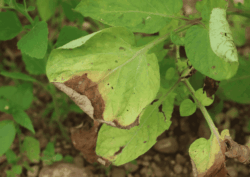
Classification of Agricultural Diseases
Plant diseases are mainly classified according to the type of pathogen that causes them.
The main types are:
1.Fungal Diseases
Fungi are among the most common and dangerous pathogens in agriculture. They can attack different parts of the plant, such as leaves, stems, roots, or fruits, and spread easily through spores, especially in warm and humid environments.
Common examples of fungal diseases:
- Downy mildew: mainly affects solanaceous crops, cucurbits, and grapevines.
- Rust: causes economically significant damage in coffee plantations and also affects legume crops.
- Fusarium: causes vascular wilt and root damage in various crops.
Characteristics:
- Leaf spots
- Discoloration and wilting of leaves and stems
- Root and stem rot
- Presence of mycelium and hyphae, which facilitate spore dispersal
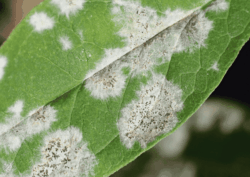
2.Bacterial Diseases
Bacteria can enter plants through wounds or stomata and spread via water, contaminated tools, or insect vectors.
Common examples:
- Bacterial wilt
- Bacterial spots
- Bacterial canker
- Bacterial rots
Characteristics:
- Wet or watery lesions
- Foul odor in infected areas
- Sudden wilting
- Discoloration or spotting on leaves
- Tumors and/or galls on stems, leaves, and roots
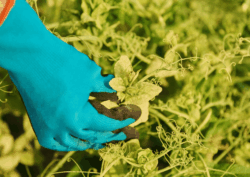
3.Viral Diseases
Viruses are more difficult to control because they require a living host to replicate. They are generally transmitted by insects (such as aphids or whiteflies) or through mechanical contact.
Common examples:
- Mosaic virus
- Leaf curl virus
- Stripe virus
- Huanglongbing
Characteristics:
- Leaf curling
- Chlorotic spots or mosaic patterns
- Stunting or deformities
- Yellowish or pale green mosaic patterns
- Necrosis and death
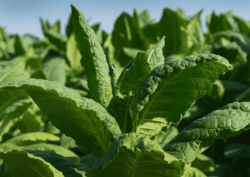
Factors that Promote the Appearance of Diseases
The development of agricultural diseases is not random but the result of a complex interaction between three fundamental elements: the pathogen, the host plant, and the environment. This relationship is known as the Disease Triangle, and understanding it is key to effective prevention.
Presence of the pathogen
For a disease to develop, a pathogen must be present in the crop environment. These organisms can remain inactive for long periods and become active under favorable conditions. Sources of pathogens include:
- Infected seeds
- Residues of previous crops
- Contaminated soil
- Infected tools
- Biological vectors: insects transmitting viruses or bacteria
Example: The fungus Phytophthora infestans, which causes late blight in potatoes, can remain latent in infected tubers during winter and reactivate at the start of the new growing season.
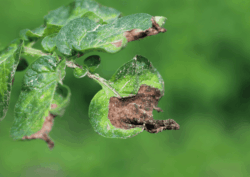
Susceptibility of the host plant
Not all plants respond the same way to pathogens. Some varieties have developed natural defenses or have been genetically improved to resist certain organisms. However, many others are highly susceptible.
Susceptibility can increase if:
- The plant is stressed due to nutrient deficiency, excess water, drought, or physical damage
- Varieties without genetic resistance are grown in areas where the pathogen is common
- Monocultures are planted for multiple consecutive seasons, facilitating pathogen accumulation in the soil
Example: Corn crops are susceptible to the maize stripe virus in regions where crop rotation is not practiced.
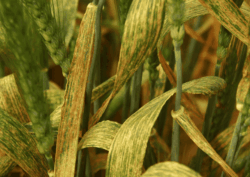
Environmental conditions
The environment is perhaps the most critical factor in activating and spreading diseases. Many pathogens can only infect or reproduce under specific environmental conditions.
a) High relative humidity
Most fungi require high humidity levels to spread their spores. Botrytis cinerea, known as gray mold, thrives in conditions above 90% humidity.
b) Temperature suitable for the pathogen
Pathogens have an optimal temperature range for development. For example, downy mildew in grapevines develops best between 20 and 25°C under constant humidity.
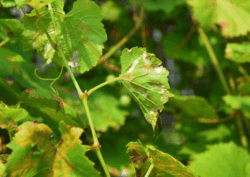
c) Wind and rain
These facilitate spore dispersal and allow pathogens to enter through wounds caused by wind abrasion or raindrop impact. For instance, rain can splash soil and spread bacteria like Xanthomonas spp. to lower leaves and stems.
d) Insufficient sunlight
Lack of light reduces photosynthesis and weakens the plant’s natural defenses. In poorly ventilated greenhouses, reduced sunlight and increased humidity increase the risk of diseases such as powdery mildew or bacterial rots.
e) Soil conditions
Compacted or poorly drained soils retain water, creating an anaerobic environment that favors fungi like Pythium and Rhizoctonia, which cause root rot. Excess or deficient nutrients also affect plant resistance; for example, excess nitrogen can make plants more prone to bacterial attacks.

Agricultural diseases are a constant threat that can compromise food security and agricultural sustainability. Addressing them requires preventive management based on cultural practices, the use of resistant varieties, and continuous crop monitoring. Only through integrated and sustainable strategies is it possible to reduce their impact and ensure more stable and healthy agricultural production.
Frequently Asked Questions About Agricultural Diseases
1. What are agricultural diseases and why are they dangerous?
They are conditions caused by fungi, bacteria, or viruses that attack crops, reducing their yield and quality, and can affect food security.
2. What are the most common types of agricultural diseases?
They are classified according to the pathogen:
- Fungi: downy mildew, rust, fusarium
- Bacteria: bacterial wilt, bacterial spots
- Viruses: mosaic virus, stripe virus, huanglongbin
3. How can you identify if a crop is diseased?
Some signs include leaf spots, wilting, root or stem rot, tumors, necrosis, mosaic patterns, and discoloration. Each type of pathogen shows characteristic symptoms.
4. What factors promote the appearance of agricultural diseases?
The presence of pathogens, the susceptibility of the plant, and environmental conditions (humidity, temperature, light, and soil quality) are key factors in the development and spread of diseases.
5. How can agricultural diseases be prevented and controlled?
Through preventive practices such as:
- Using resistant varieties
- Crop rotation
- Tool hygiene and vector control
- Proper soil management, irrigation, and fertilization





 (956) 574-8280
(956) 574-8280 info@ferti-organic.com
info@ferti-organic.com